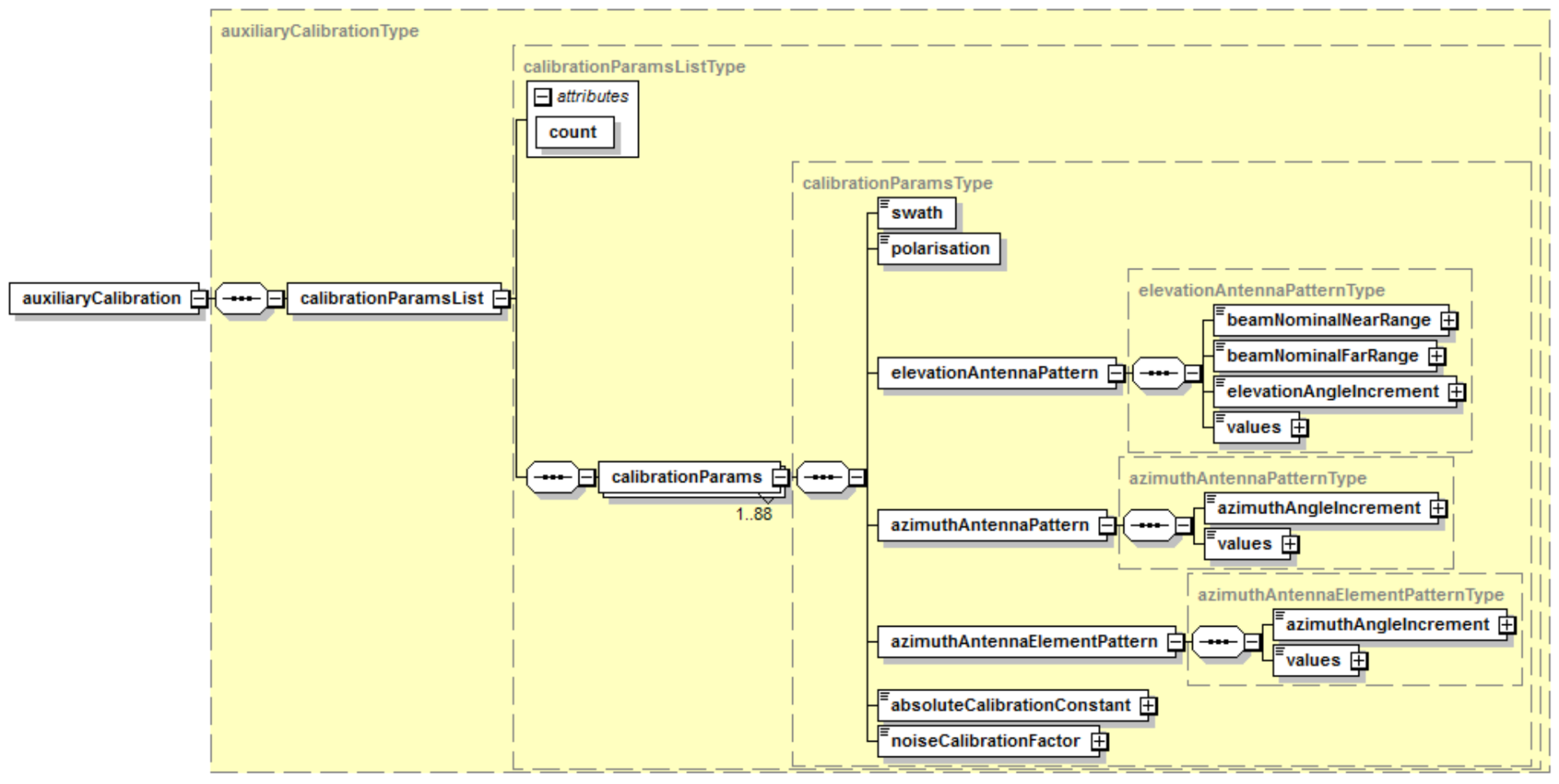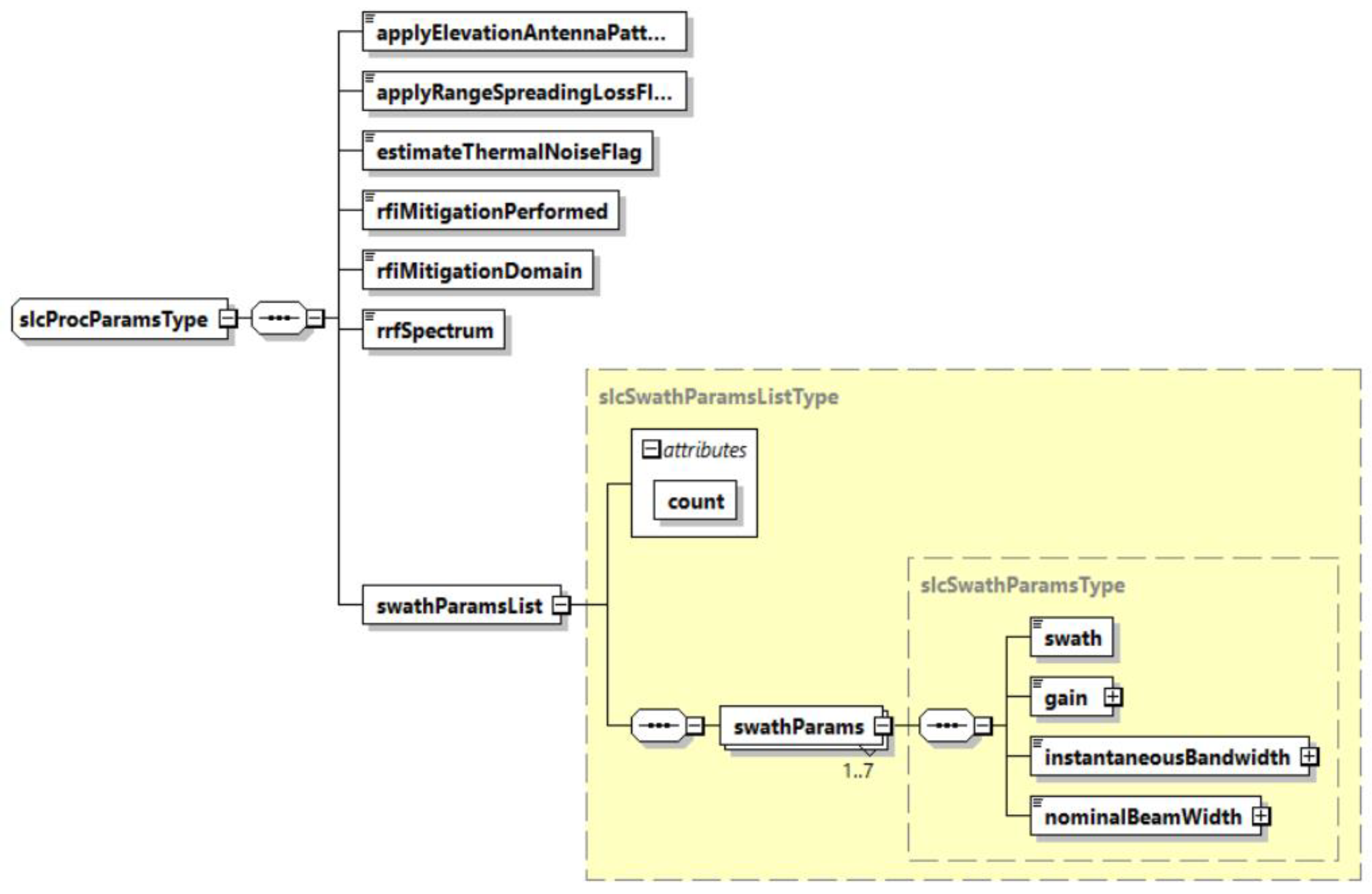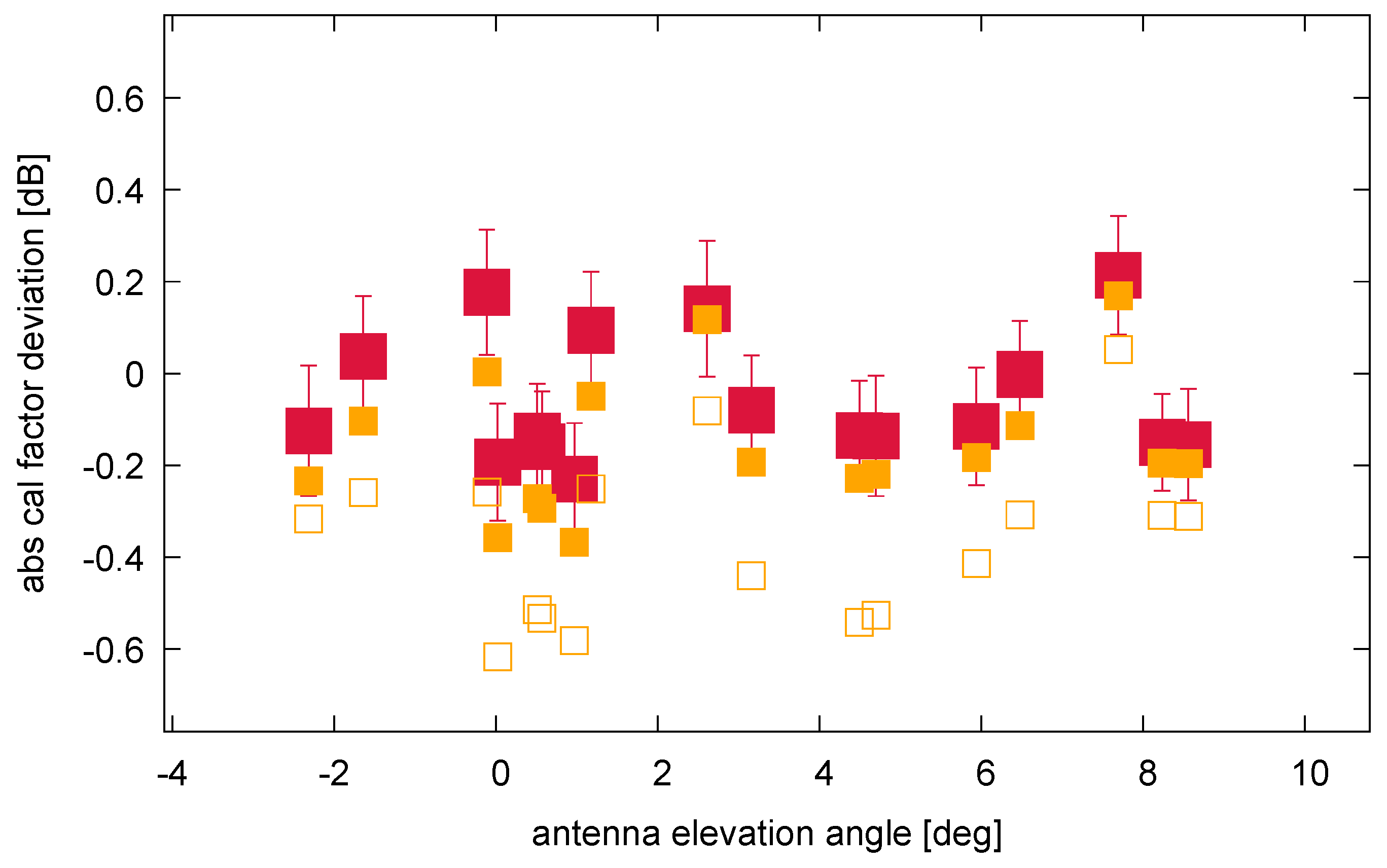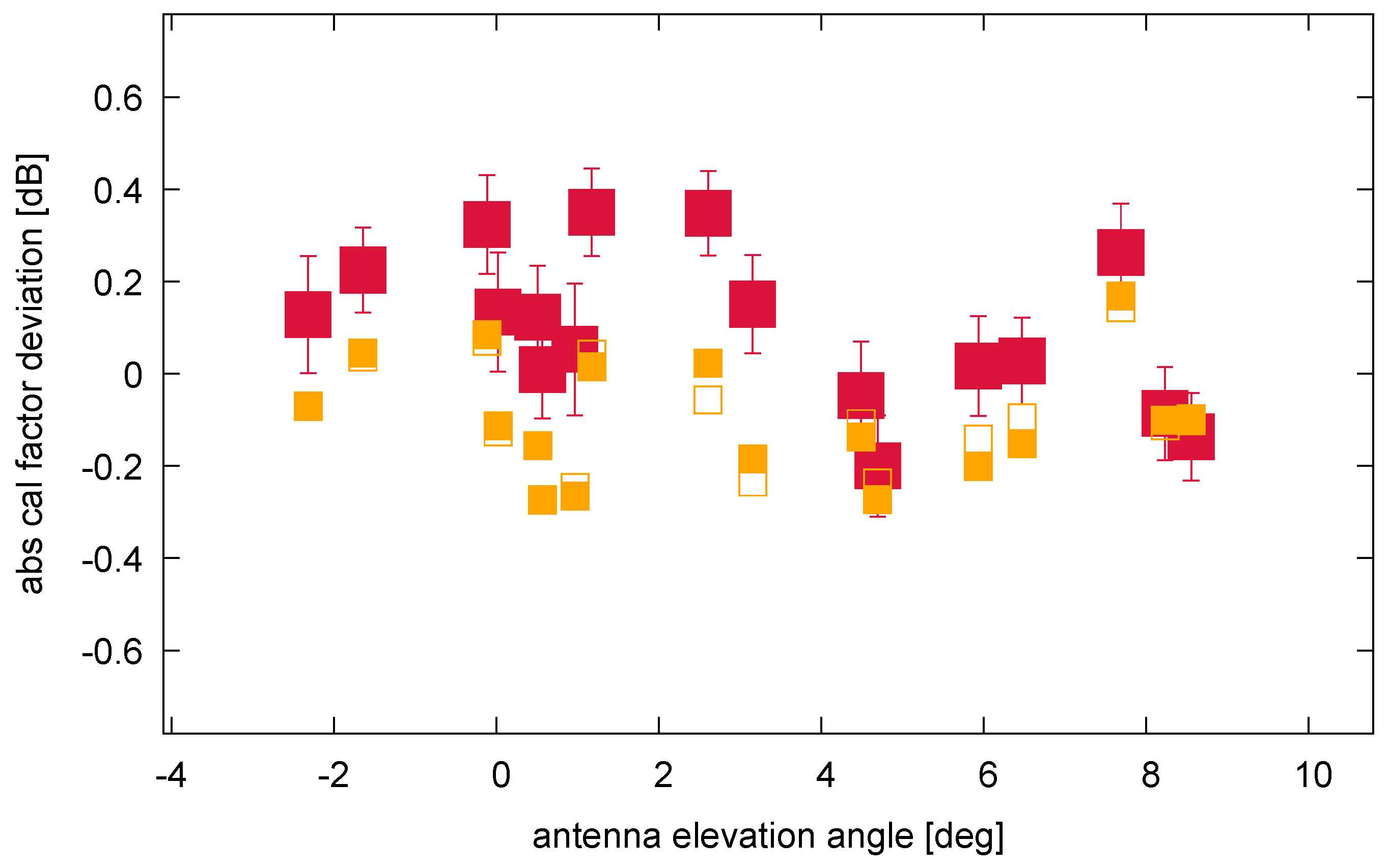3.1. Evaluating Test Cases
For test purposes, a limited number of SAR data products containing point targets responses from the DLR calibration site have been processed with different configurations (elevation antenna pattern and corresponding auxiliary products). That means that in addition to the original L1 SAR data product, which was created by the nominal processing chain, an additional re-processing was performed using the same SAR data acquisition L0 product but with different auxiliary data and a given IPF version. The input parameters (auxiliary files and IPF version) used for the SAR data processing of both original and reprocessed data are summarized in
Table 5.
The radar cross section of each reference target response was evaluated and the difference between results derived from original and reprocessed SAR data products was calculated for the two test cases acquired on 3 August 2019 and 11 July 2017. This derived backscatter difference is finally compared with the predicted offsets between used configurations according to Equation (
3). The data-take corresponding to the 3 August 2019 test case was acquired in a descending orbit direction. In this SAR data product, four reference targets could be evaluated. For the 11 July 2017 test case, acquired in an ascending direction, six reference targets were available. Note that while the used trihedral corner reflectors produce responses for co-polarization channels, the used transponders were operated for co- and cross-polarized channels.
The evaluated results for the 3 August 2019 and 11 July 2017 test cases are listed in detail for each available reference target and polarization channel in
Table 6 and
Table 7, respectively. Although the backscatter difference reaches up to 0.4 dB between evaluated SAR data product versions, this offset is sufficiently predicted by Equation (
3). The remaining deviation between the derived RCS difference (between original and reprocessed SAR data products) and the predicted backscatter offset is below 0.04 dB. This low remaining difference is thought to be due to numerical errors from SAR data processing and point target evaluation.
3.2. Long-Term Monitoring Results
Sentinel-1 acquisitions (S1A and S1B) over the DLR calibration site were used for long-term monitoring of the radiometric performance. As these targets have been operated since the commissioning phases of S1A and S1B, adequate data acquisitions are available which cover an observation period lasting several years. From the corresponding SLC L1 SAR data products, the target impulse responses are evaluated for S1A and S1B. Then, the RCS is derived from each impulse response and compared with the nominal reference value of the corresponding target. In terms of radiometric calibration, it is the deviation from the absolute calibration factor which is also annotated in the SAR data products valid for all modes and all polarizations of the SAR system. The deviation of the absolute calibration factor can be used as an indicator of the radiometric performance of the SAR system; it is a measure for the radiometric stability and radiometric accuracy of the SAR system.
The deviation of the absolute calibration factor derived from measurements over the DLR calibration site is depicted in
Figure 3. While the top subplot shows results from S1A acquisitions, the bottom subplot contains S1B results. Each single point represents the deviation of the calibration factor derived from the impulse response function of a certain target for a certain acquisition. The results from the VV polarization channel are marked in red; the results from the VH polarization channel are marked in blue.
Figure 3 is based on original SAR data (L1 SLC products available, e.g., at S1 datahub) which were created by the operational processing chain with processing parameters valid and used at processing time. The vertical lines mark the dates when updates of the antenna pattern were applied in the nominal processing chain (see
Table 2). These updates produce artificial steps (offsets) in the radiometric performance which are clearly visible.
The effect of the applied re-compensation according to Equation (
3) is depicted in
Figure 4. Based on the same SAR data products (L1 SLC products), the described correction procedure was applied without further reprocessing of the SAR data products. As a consequence of the successful application of the proposed method, the artificial steps in the radiometric performance due to antenna pattern updates are vanished and are finally no longer visible in the timeline within
Figure 4. The remaining outliers are thought to be mostly due to unstable weather conditions, e.g., strong rain or snow.
Using the proposed correction method, the acquisitions over the DLR calibration site and over a period of 57 months (from April 2017–December 2021) can be used to derive the radiometric accuracy for both Sentinel-1 SAR systems. The mean values and standard deviations for the derived absolute calibration factor without and with the proposed compensation are summarized in
Table 8 for S1A and S1B. By applying the re-compensation, the overall standard deviation is reduced for S1A from 0.22 dB to 0.20 dB, while the overall mean value moves by about 0.2 dB from −0.10 dB to +0.09 dB (see
Table 8). For S1B, the standard deviation remains constant at 0.21 dB with a mean value difference of 0.14 dB considering results without and with compensation; this indicates less strong antenna pattern updates for this unit in the past.
For interpreting the results in
Table 8, it should be mentioned that the balancing of the antenna pattern and updating the elevation antenna pattern (see
Table 2) was exclusively conducted by using rainforest acquisitions in the past. Considering this fact, the current study can be seen as an independent verification measurement. For future antenna pattern updates of Sentinel-1, it is strongly recommended to consider accurate reference targets also for radiometric balancing over the antenna elevation angle range.
Furthermore, the calibration factor dependency from the antenna elevation angle is investigated for the point target time series. For this purpose, the derived calibration factors are grouped by acquisition geometry. As the targets are usually observed with different acquisition conditions (different sub-swathes, ascending or descending orbit, different relative orbit numbers), the look angles of the targets differ between acquisitions. As the Sentinel-1 spacecraft is operated with a repeat cycle of 12 days, the same geometric conditions are repeated, and the targets are observed by the SAR instrument with recurrent and (nearly) constant antenna elevation angles. For the long-term monitoring period, the 6 reference targets are visible under 17 different antenna elevation angles, each of this configuration represented by a sufficient number of measurements (between 100 and 150).
The dependency of the calibration factor as a function of antenna elevation angle is depicted in
Figure 5 and
Figure 6 for S1A and S1B, respectively. Each symbol represents the reference target measurement with a specific geometric condition (and antenna elevation angle) which is repeated. The red solid squares and red error bars depict the mean values and standard deviations derived from the time series considering the proposed antenna pattern compensation for the current configuration.
The orange solid and open squares within
Figure 5 and
Figure 6 represent mean values if antenna patterns from previous antenna pattern configurations are used for re-compensation. The radiometric differences between the symbols at the same antenna elevation angle indicate the changed pattern compensation between the used configurations which reach up to 0.5 dB. If the SAR data are not corrected for the related antenna pattern and processing gain configurations, these systematic errors remain and are present, e.g., as jumps in the backscatter timeline for observed targets at this elevation angle at the date of update activation (see
Table 2).
Furthermore, the small error bars in
Figure 5 and
Figure 6 indicate that the gain deviation for a certain target configuration with a certain antenna elevation angle is low, in the order of 0.1 dB. In fact, the variation is slightly lower for S1B compared to S1A, indicating a lower instrument variation of S1B compared to S1A. In contrast to this, the variation of the mean values over the elevation angle is higher in the order of ±0.2 dB for S1A and about ±0.3 dB for S1B. That means that the radiometric accuracy could be slightly improved in the future with an updated antenna pattern.












